Saints, Incas, and Chronicles: Corpus Christi in Cuzco

Cuzco’s Saints parade through the streets today in procession, accompanied by troupes of devotees, often organized into dance fraternities. Each saint and dance has their own melody to mark their passage and identify them to the people of Cuzco who line the streets to see them and witness their visit to the streets along with the different degrees of devotion shown by their followers.
When the saints are not in the streets, when they are in the Cathedral, people say they council with each other and gossip about their parishes and other saints. The people in the streets have reciprocated with gossip about the parishes and the saints.
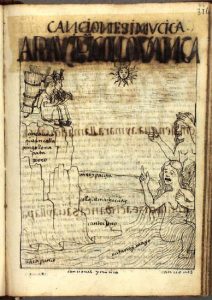
I have heard several times, for example, that San Antonio is not happy, and neither are his followers. He is the patron of single persons and of Cuzco’s hundreds of years old university, the Universidad de San Antonio Abad de Cuzco or UNSAAC as it is mostly known.
Once he had his own chapel, the beautiful one up by the Nazarenas and Monasterios Hotel. His chapel was privatized (secularized) for the sake of developing the fine hotels. Now he is housed in some one else’s chapel, the Chapel of San Cristobal.
The parishoners there, out of loyalty to their patron, it is said, treat San Antonio as second class and will not let him or his followers leave the chapel until San Cristobal has already gone. There are jealousies, people say, and the saint is unhappy.

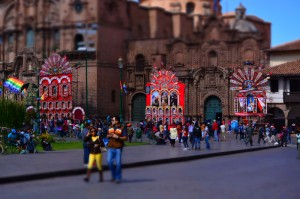
People also say that at night, when the saints are closed up in the Cathedral holding their own reunion and gossip fest, the people can give in to temptations. They can eat and drink with abandon, since the saints are not around to see them or sanction them.
This idea of “eyes that cannot see”, ojos que no ven, as one giving license is an old one here in Peru. Certainly it is something with deep roots in Spanish- and Portuguese-speaking countries. Nevertheless, the feasts are not only Spanish, they also have deep indigenous roots.
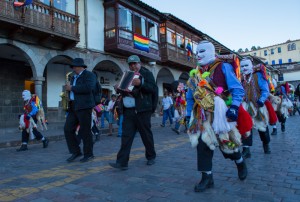
The Chronicler Guaman Poma de Ayala, who himself was a native of Peru and a native Quechua speaker discussed festivals, along with their song and dance, in a pictorial and textual letter he penned to the Spanish King in the early 1600s.
Guaman Poma insisted that the songs and dances were not for the purpose of witchcraft or, we could argue by extension given the priestly fears of the day, of the devil nor were they idolatrous. He insists that “in these feasts that every ayllu (kin group or nation) and every sector has no one should intervene nor should any judge worry the poor in their work and little feasts, as well as in their poverty, which make they sing and dance, and eat among themselves.”
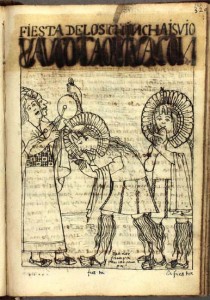
Inevitably Guaman Poma said this because many people were deeply concerned about Indigenous culture and whether it was Catholic enough or should be stamped out and replaced with Christianity.
While he was a younger man, a hysterical fear broke out among the clergy in the Archdiocese of Lima that the Church needed to stamp out idolatry. Intriguingly, as part of this, a notion spread widely that Indians had started a resistance to Spanish rule by dancing and singing. In the literature this is called the takiy onkoy, the dancing sickness. Guaman Poma evidently worked as a translator for the priest who gathered information, Father Albornoz.
At the time other priests in Huarochiri, a town in the archdiocese of Lima gathered a collection of stories in Quechua that deal with the historical actions of deities in struggling with each other, gossiping and partying. Besides the interaction of these sacred heros, the text establishes the dances and feasts that communities should hold, as part of keeping the acred figures involved with the life of ordinary peoples. It also locates these gods in the landscape, rocks, crags, streams and lakes, to which the dances inevitably refer.
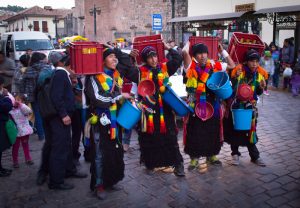
It is possible Guaman Poma was responding to this notion in his defense of fiestas, dances, and song. His words certainly sound like a refutation.
Nevertheless, Guaman Poma calls a taqui, takiy, a ceremonial dance, even though today the word is mostly used to refer to song while tusuy is the word more commonly used for dance. In this he picks up a tension that goes even up to today about the nature of indigenous song and dance which even saturates Corpus Christi and its desires for the absolute supremacy of Christianity and ambivalence about indigenous ways.
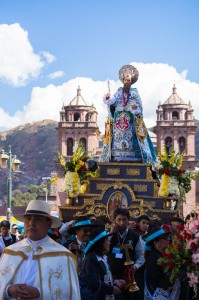
In his first image, he prefaces a description of the dances of the four quarters of Tawantinsuyo, the Inca Empire, with an image that locates song and dance in the landscape from which the Huatanay River comes, the river that courses through the Cuzco Valley. Within the river, he shows enchantresses, mermaids, who still to this day are considered to live in springs and pools around Cuzco. They also play an important role in tuning musical instruments, according to people.
If nothing else, Guaman Poma is locating dance and song in nature, the same kinds of places from which people were said to have originated in many tales, when they came forth into this world. He also locates it as relating to different sections of Inca society, such as the four quarters of Tawantinsuyo.
These not only organized the entire space of the Inca Empire, they also organized the city of Cuzco. This is very relevant today when the various saints, from their chapels in each of the traditional neighborhoods of Cuzco, show different dress, different dances and processions, and music all within the frame of devotion to a Catholic Saint and in the company of religious (especially parish priests).
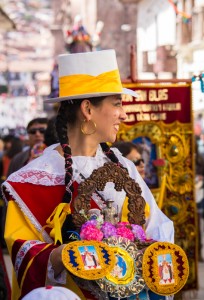
Sometimes, though, it is hard to know if the frame of Catholicism wins out in the historical struggle, or if the indigenous people of each parish have somehow embedded the European figures in indigenous ways, like the cloth with which they are dressed and the Churches where they are housed.
Both are probable, the Catholicization and the Indigenous appropriation and dressing. Together these play a part in the politics of every parish and in the divisions, competitions, and solidarities that divide and join the parishes.
Whatever else you see today, you will see something deeply real, that strikes roots very deep in the past. The dances will not be finely choreographed ones, like you saw during the last week, which require a stage or a fixed place in order to be performed such as in front of the reviewing stand.
These are dances that occur in movement over space, a claiming of space for the saint and the people. These dances are also embedded in confraternities organized in devotion to the saints and to perform social organization in the neighborhoods. While many of them have decades or more of existence, they can also change as new styles and new dances are drawn in.




